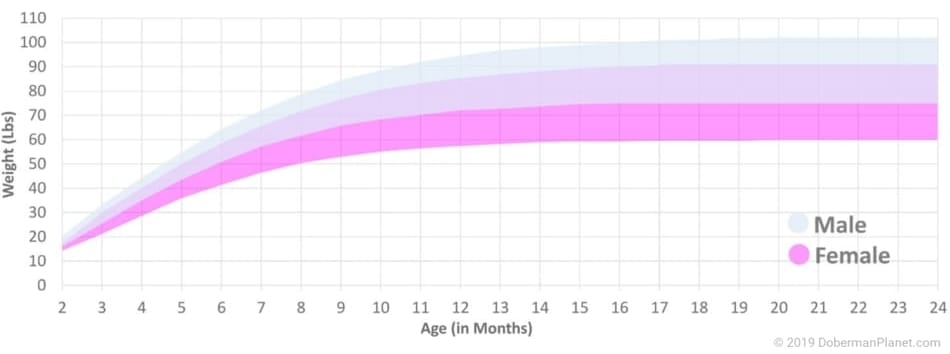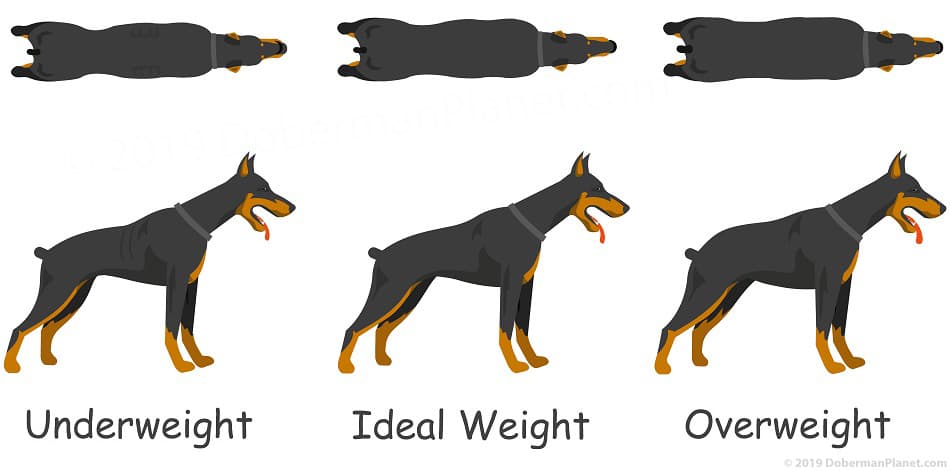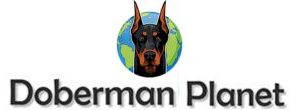
There are a lot of people out there who are curious about how much a Doberman weighs, and some who just want to know if their dog is overweight or underweight compared to the average Doberman. You may have even seen extra large, or “Goliath” Dobermans offered for sale before. Certainly, the breed can vary significantly in size, but only a specific weight range is considered to be the “breed standard” by the American Kennel Club (AKC). Any bigger or smaller, and the dog isn’t not considered a standard Doberman.
How much does a Doberman Weigh? The American Doberman Pinscher’s weight is 75 to 100 pounds for males and 60 to 90 pounds for females. European Dobermans weigh 88 to 99 pounds (40-45 kg) for males and 71 to 77 pounds (32-35 kg) for females.
These weights are per the American Kennel Club (AKC) Doberman breed standard for the American Doberman Pinscher and the Federation Cynologique Internationale’s (FCI) breed standard for the European Dobermann.
The important thing to remember is that these breed standards aren’t necessarily a reflection of reality. What I mean is that these kennel clubs have a set standard of what the ideal weight for the dog is to compete in their shows and get certification papers. This number doesn’t always reflect the real-world weight of these dogs, however.
As an example, the European Dobermann almost always outweighs its American counterpart in the real world, but you wouldn’t know that from the official numbers. That’s because the AKC allows for more variation in the weight of their American Doberman Pinschers while the FCI has a much stricter (and tighter) allowed weight range for their Dobermann. So don’t let the range of accepted weights by the kennel clubs confuse you with how much these dogs normally weigh. Below I’ll tell you what you can expect in the real world.
Doberman Growth Chart (Weight vs. Age)

| Age | Male Weight (Min – Max) |
Female Weight (Min – Max) |
|---|---|---|
| 1 Months | 10 – 18 lbs | 10 – 15 lbs |
| 2 Months | 18 – 21 lbs | 15 – 19 lbs |
| 3 Months | 26 – 32 lbs | 21 – 30 lbs |
| 4 Months | 35 – 44 lbs | 29 – 40 lbs |
| 5 Months | 44 – 54 lbs | 36 – 50 lbs |
| 6 Months | 50 – 64 lbs | 41 – 59 lbs |
| 7 Months | 59 – 71 lbs | 48 – 65 lbs |
| 8 Months | 61 – 79 lbs | 50 – 71 lbs |
| 9 Months | 66 – 85 lbs | 52 – 78 lbs |
| 10 Months | 69 – 89 lbs | 56 – 80 lbs |
| 11 Months | 70 – 91 lbs | 58 – 83 lbs |
| 12 Months | 71 – 94 lbs | 59 – 85 lbs |
| 13 Months | 72 – 98 lbs | 59 – 88 lbs |
| 14 Months | 74 – 98 lbs | 60 – 89 lbs |
| 15 Months | 75 – 99 lbs | 60 – 89 lbs |
| 16 Months | 75 – 100 lbs | 60 – 90 lbs |
| 17 Months | 75 – 100 lbs | 60 – 90 lbs |
| 18+ Months | 75 – 100 lbs | 60 – 90 lbs |
This growth chart shows the approximate growth rate (measured in pounds) of a Doberman Pinscher. The chart is based on the AKC’s Doberman Breed Standard. As you can see from the chart above, the Doberman’s growth is pretty significant during the first year of its life. After one year, the Doberman is considered to be an adult and at its full height, although weight gain continues, although at a slower rate, for about the next year as the dog’s frame fills out.
Use this chart as a general guideline of what to expect as your Doberman grows. It should only be considered to be a rough estimate however as the weight of Dobermans varies greatly. If your dog falls outside of the shaded region of this chart at any given stage of growth it doesn’t necessarily mean they’re unhealthy. Of course, if you have any concerns about your dog’s weight, it’s best to consult with a qualified veterinarian.
Rule of Thumb: The average growth rate of a Doberman puppy is roughly 10 pounds of weight gain for every month of age.
One general rule that Doberman owners use to remember the growth rate of the average Doberman is “ten pounds every month.” That means they should weigh 20 pounds at two months of age, 30 pounds at three months of age, 40 pounds at four months, and so on. This rule is generally fairly accurate for male Dobermans until about seven or eight months of age. At that point, the Doberman’s weight gain rate begins leveling off.
For female Dobermans, you can use the same rule if you subtract about 5 pounds from that weight. So you can generally expect a female Doberman to be about 15 pounds at two months of age, 25 pounds at three months, 35 pounds at four months, and so on. Again, please remember that this is a general “rule of thumb” and is certainly not a perfect calculation.
Average Doberman Weight by Age
While the above chart will show you the approximate range in weight a Doberman is likely to be at any given age, the table below will show you what the average weight (or “mean” weight) is at any given age. Your dog might be above or below this, and that’s fine, these are just averages so you can gain a better understanding of their growth pattern.
| Age | Male Weight (Average) |
Female Weight (Average) |
|---|---|---|
| 2 Months | 19 lbs | 17 lbs |
| 3 Months | 30 lbs | 26 lbs |
| 4 Months | 40 lbs | 34 lbs |
| 5 Months | 49 lbs | 43 lbs |
| 6 Months | 59 lbs | 50 lbs |
| 7 Months | 65 lbs | 56 lbs |
| 8 Months | 70 lbs | 60 lbs |
| 9 Months | 75 lbs | 65 lbs |
| 10 Months | 79 lbs | 68 lbs |
| 11 Months | 81 lbs | 70 lbs |
| 12 Months | 84 lbs | 72 lbs |
| 13 Months | 85 lbs | 74 lbs |
| 14 Months | 86 lbs | 74 lbs |
| 15 Months | 88 lbs | 75 lbs |
| 16 Months | 88 lbs | 75 lbs |
| 17 Months | 88 lbs | 75 lbs |
| 18+ Months | 88 lbs | 75 lbs |
The average adult male Doberman weighs approximately 88 pounds and the average adult female Doberman weighs approximately 75 pounds.
The table above should be considered as only a guideline. Every dog is different and Dobermans are known to have a wide variation in their weight.
When getting a new Doberman puppy, the best advice I can give you is to talk to your breeder. They should have an idea of the family history and how your pup’s parents developed over time and can provide you with a better idea of what to expect from your specific puppy.
Age When Full Grown
At 1 year of age, a Doberman will have reached its full-grown height and by 2 years of age, it’ll have reached its full-grown weight. However, some Dobermans will reach a stable weight closer to 18 months. The height and weight of the dog are typically stable at this point, and their joints are fully formed. Usually, there is very little (or no) filling out of the dog’s frame left to do. At that point, their bodies are ready to handle more strenuous types of activity.
If you want a more in-depth resource as to exactly when a Doberman reaches certain stages as they grow, see my article When is a Doberman Full Grown here.
Sometimes there will still be minimal growth in a Doberman after the age of two years in terms of weight, but the height of the dog should be basically stable. Although the Doberman is still not considered to be “in their prime” until about three years of age.
American Doberman Weight
The growth chart depicted above is based primarily on the AKC’s breed standard for the American Doberman Pinscher and, in my experience, is fairly accurate. American Dobermans are leaner than European Dobermans and generally weigh a bit less.
The AKC lists the following weights as the “breed standard” for the American Doberman Pinscher.
- Males: 75 – 100 lbs
- Females: 60 – 90 lbs
It’s nice to see that the AKC’s breed standard attempts to account for the broad range of weights for the Doberman Pinscher. This is why I decided to model the above growth chart off of their estimates. However, it’s worth noting that it’s certainly still possible to have a healthy Doberman who falls outside of the above-mentioned weight range.
European Doberman Weight
The European Doberman (also called “Dobermann”) has a body type that’s a bit bulkier and more muscular than the American variant. Their bone structure is also a little thicker. This is most apparent in the blockier head and snout, as well as their broad chest. This means they generally weigh more. The growth chart shown above was modeled around American Dobermans but can be used to estimate the weight of a European Doberman as well.
A European Doberman’s weight will usually fall near the top edge of the growth chart’s shaded region. The final adult weight of a European Doberman will more typically be near the 100-pound mark.
The Federation Cynologique Internationale (FCI) defines the following as the breed standard weights for the European Doberman.
- Males: About 40 – 45 kg (88 – 99 lbs)
- Females: About 32 – 35 kg (71 – 77 lbs)
The breed standard of the FCI listed above for the European Doberman has a much smaller weight range for the European Doberman than the AKC has for the American Doberman. It’s worth noting that the FCI adds the language “about” before their listed weights, likely in an attempt to account for the broad range of weights that are possible for the Doberman.
The European Doberman has an equally broad range in adult weights within the breed as the American Doberman, it appears though that the FCI just has stricter requirements for their breed standard than the AKC does.
For more information about how European and American Dobermans are different (including detailed diagrams of both dogs), see my article American vs. European Doberman: A Side-by-Side Comparison.
Predicting How Much Bigger Your Doberman Puppy Will Get
Besides age, there are other methods Doberman owners have used to help determine how big a Doberman puppy will be as an adult with relatively good accuracy. These are:
- DNA Testing – Modern at-home DNA health tests, such as these Embark DNA test kits can give you an incredibly deep look into your dog’s genetic health including a puppy’s adult size! The Embark DNA test kits (a favorite among Doberman owners) test for five specific genes that are known to influence about 85% of the variation in their adult size. You can read more about how to DNA test your Doberman at home here.
- Parents – Looking at the size of your Doberman puppy’s parents is a good indicator of their genetics in terms of growth and can give you a good general sense of your dog’s growth potential. Although DNA tests seem to be more accurate since a puppy can inherit growth genes from its grandparents as well.
- Size in Relation to Littermates – If you know how large your puppy’s parents are, you can then compare your puppy to its littermates to help predict how large he or she is going to get. If they’re the largest in the litter, it means your dog will likely be as big (or bigger) than its parents.
- Paw Size – This has been a go-to indicator for Doberman owners for years. The general thinking is the larger your Doberman’s paws are, the bigger they will be as an adult. This is because larger paws are needed to support a heavier dog so it’s a good indicator of your dog’s genetics in terms of size.
- Their 4-Month Weight – Take your Doberman’s weight at 4 months old (or about 16 weeks) and multiply it by two, then add 5 pounds. That formula will get you close to their adult weight. So, if your Doberman weighs 30 pounds at 4 months old then take 30 and multiply it by 2 to get 60 pounds. Then add 5 pounds and you come up with an expected adult weight of about 65 pounds.
- Age When Spayed or Neutered – If your Doberman is neutered before reaching full maturity (6 – 24 months of age), then it’s more likely that they will be taller. This is because the dog’s hormones have a large impact on when the growth plates close which causes their legs to stop growing. Spaying and neutering removes these hormones. Some owners report that they end up with taller, but thinner, Dobermans when they’re spayed or neutered early. This is also backed up by recent studies such as this one published in the National Library of Medicine.
Is Your Doberman Overweight or Underweight?
The best way to determine if your Doberman is overweight or underweight is by a visual inspection. The reason you can’t rely on numbers and graphs for this is simply that, just like in humans, every dog’s body is different.
Some have smaller frames while others have larger ones, and a Doberman whose used to more strenuous activity and possesses more muscle mass, as a result, will weigh more than one who doesn’t. This doesn’t mean that either dog is necessarily unhealthy, however.

Underweight Dobermans
If your Doberman is underweight (especially if they are 10% or more under their ideal weight), it can lead to long-term health problems, quality of life concerns, degradation of their emotional state, and other issues. Here’s how to tell if your Doberman is underweight:
- Ribs, pelvic bone, and vertebrae are visible or starting to become visible from the side.
- An obvious and elongated appearance of the waist when viewed from above.
- No discernible fat around the rib cage area—feels like the skin is lying directly on the ribs.
- Multiple individual bones of the rib cage are easily visible from the side.
- Loss of muscle mass may be apparent.
Ideal Weight Dobermans
When your dog is at an ideal weight, it’s a great indicator that they are happy and healthy. They are fit and ready for activity. Some signs that your Doberman’s weight is within the ideal range are:
- The ribcage may be slightly visible—a “soft outline” of the ribcage may be apparent.
- A minimal fat layer can be felt between the skin and the ribs.
- The waist is distinguishable when viewed from above without excessive bony protrusions.
- The abdomen area tucks smoothly up from the ribcage to the hind legs.
Overweight Dobermans
Just like with humans, there are various health concerns if your dog is overweight such as joint issues and increased susceptibility to life-threatening diseases. Being overweight also increases the chances of injury during strenuous activity. Your dog may become lethargic and their emotional well-being may suffer as a result. Here are some typical traits of an overweight Doberman:
- The ribcage is not visible from the side or above, excess fat covers the ribs.
- The waist may be slightly discernible, although is not prominent from above.
- Abdominal tuck is lacking or minimal—the stomach area may appear to “hang down”.
NOTE: Make sure you’re always feeding your Doberman quality food that is NOT grain-free since recent research suggests grain-free diets are linked to heart issues in the Doberman breed. You can see the current list of my recommended best foods and treats for Dobermans here.
Increased Medical Risks with Larger Dobermans
Larger dogs tend to die younger. In fact, the majority of differences in life span among various dog breeds can be explained by genetic factors that control differences in body weight (source). In Dobermans, there are certainly a few health conditions that they are considered to be more prone to the larger that they are including:
- Dilated Cardiomyopathy (DCM) – This condition involves a weakening of the heart muscle and affects a very large number of Dobermans. In dogs in general, DCM most commonly affects larger dogs (source). To learn more about how serious DCM is in Dobermans specifically, and how you can help protect your dog, see our article Doberman Pinscher Dilated Cardiomyopathy (DCM) Simplified here.
- Hip and Joint Problems – Dobermans are at a higher risk of hip dysplasia which is a genetic condition that causes the hip to not form entirely correctly. A common treatment for this condition is to have the dog lose weight since it puts less strain on the hip. More weight means there’s more strain. The increased size also means there’s more pressure put on your dog’s joints as they move which can lead to a higher chance of osteoarthritis.
- Lower Tolerance to Heat – Larger dogs have more difficulty handling hot weather than smaller dogs (source). Dobermans in general have been more susceptible to heat, but this is especially true if your dog has a few extra pounds on him or her.
- Increased Cancer Risk – Overweight dogs are at an increased risk for many types of cancer (source) and Dobermans are known to be prone to various forms of cancer such as osteosarcoma (bone cancer).
Final Thoughts
The Doberman Pinscher is a large and impressive dog in my opinion, although technically they’re classified as a “medium-sized” dog. The American Doberman Pinscher is known for toned muscle and little body fat (think more like a long-distance runner, not a bodybuilder), while the European Doberman is known for a bigger, heavier, and more muscular body type.
It’s always good to make sure your dog is growing correctly and on track to be a healthy weight as an adult. Don’t ignore any sudden changes in your dog’s weight, as it could be an indicator of an underlying health concern
This is why I strongly urge Doberman owners to always DNA health check their Dobermans so they know what genetic issues they might be up against. Don’t just watch the years tick by and wonder what might be in store for your Dobie. I wrote this DNA testing guide specifically for Doberman owners to help you out with that.
The most important thing I can stress in this article is that every Doberman really is different. The weights I have provided here should really only be used as rough estimates. The best way to see if your dog is truly at a healthy weight is to consult with a qualified veterinarian. I wish you and your Dobie a long healthy life together!
Related Questions
At what age is a Doberman full grown? At 1 year of age, a Doberman has reached its maximum height and is considered to be an adult, although they will continue to gain weight until about 2 years of age.
At what age has a Doberman reached their full height? A Doberman will reach their maximum height at about 1 year of age (12 months).
How much should a male Doberman weigh? An adult male Doberman should weigh between 75 to 100 pounds when full-grown.
How much should a female Doberman weigh? An adult female Doberman should weigh between 60 to 90 pounds when full-grown.



my doberman puppy will be 4 months old tomorrow and he weighs 50 pounds he mother is 85 and he sire is 105 is it to late to have his ears cut
Ear cropping timing really has more to do with the dog’s age than their weight. This is because their ear cartilage hardens as they get older and if the ears aren’t cropped and posted in place when this happens, they won’t stand. I would see a vet who specializes in ear cropping so they can examine the ear cartilage to see if it has firmed up yet, but in general, ear cropping shouldn’t be done much over 12 weeks of age. So my guess would be that it is probably too late.
Sir i have a 7 month old male dobe and a 2 month old female dobe. My problems is the female puppy likes to tease and play with the 7 month old witch is 24 inches and i am afraid that the bigger dog might hurt her since she is small. The male dobe plays kinda hard somtimes the puppy cries when it gets too rought but keeps on teasing the older dobe. What should i do?
I would certainly keep an eye on their play, keep it fully supervised until she puts on some size, and separate them if things get too rough. Keep in mind that yelping or crying is a very common way for young pups to communicate that things are getting too rough and doesn’t necessarily mean they have been injured or anything like that. They communicate that way quite regularly with other dogs, which is totally normal. That being said, definitely listen to her and take appropriate action of course. Just don’t stress too much about the yelps in and of themselves.
My doberman puppy is 4 and a half months. It is 20Kg in weight and 23 and a half inches in height. Do you think that would be big enough for his age?
Definitely! It sounds like he’s right on track.
We are looking to adopt a rescue doberman that is nearly 2 years old and only 43 pounds. We had our first meet with her yesterday and she looks like typical doberman, just 2/3 normal size. (I’ve had 3 female dobes in the past that were all 65-70 lbs.) She has been in foster care nearly a year, is playful and has tons of energy. She was rescued from an abusive situation. Is it possible she is just a small dog, or more likely she was malnourished as a puppy that would have affected her growth?
Both are possible. Although I would say it’s more likely she is just a smaller dog. The information in the graph on this page (for example) is just a rough guideline. These dogs do naturally vary quite a bit. If it had been malnutrition I would expect some other health issues or abnormalities.
Hi,
My Dobermann is now just over 7 months old and weighs in at a whopping 85lbs. The vet has said he looks perfect, he’s gained 30lb in the past 2 months and is extremely happy and
I can still see a very small amount of rib, how much more weight can he gain…..When he’s stood up he looks perfectly in proportion, when he lies down he looks like he has a bit of a bigger belly – which he has had since we got him.
So I’m not sure if he’s just ‘sturdy’.
Yeah, I would rely on the vet since there’s no substitute for seeing the dog in person. How much the stomach tucks up underneath the dog is a good way to tell overweight vs. underweight. I use that and also how much hip can be seen from the top looking down as good gauges quite often.
Male doberman
Hi there, our family will be adopting a 4-month old male doberman. He weighs 40 lbs, which is fine based on the age-weight chart. My only concern is I’m afraid he’s going to be too humongous for us to handle when he’s older (I’m only 115 lbs, and we have a 7-year old). Do you have any recommendations on how to keep him on the right track and not become overly ginormous? Thanks.
Really, the only thing you should do is make sure he’s properly fed with a quality diet. There’s nothing you could (or should) do about his genetics, he is going to be whatever size he’s going to be. Certainly, don’t underfeed him out of fear of his adult size. This could cause serious health issues in a developing dog. The best thing you can do is to socialize him as much as possible (introduce him to new people, kids, and animals constantly) and make sure you remain the alpha in the house. Don’t let him run through doorways before you do, make him listen to you at all times, focus on training him with command and tricks, and make sure he knows what’s expected of him. If you do these things, he’ll be super easy to manage as an adult dog no matter what his ultimate size is.
Hi!
My 4th month female doberman is weighing in about 31 lbs.
I have had some trouble feeding her as she refusing hard food.
The vet recommended a raw meat diet.
She is extremely happy and healthy!
But won’t eat.
I’m confused! Help!
At 4 months and 31 pounds for a female, she’s not at an unreasonable place with her weight yet. But not eating is certainly very concerning! Many medical problems can start with a lack of appetite. Definitely work with your vet (I’m not one). I would encourage your vet to first make sure there are no underlying medical problems. Blood work could be very helpful, as well as an EKG or Holter monitor to check heart functions. I would just make sure your Vet is ruling out the worse case scenarios first… like DCM, liver problems, etc.
Hello my don’t Baker is 5months old and 51 pounds.. what is a good back yard exercise I can use for muscle growth ..thank you.
Sounds like Baker is right on track! He certainly isn’t small for his age. Honestly, at only 5 months old you shouldn’t worry about building muscle just yet. Wait until they’re full-grown (at 2 years of age). There are so many changes he still has to go through. Just keep him active and healthy—that’s all you have to worry about right now. Enjoy the puppy years!
Hello, We are getting a doberman puppy (female), and would like to get a dog bed for her. I found a used one that is 40 inches by 25 inches. Do you think that would be big enough for her when she is full grown? Thanks.
That’s pretty close to the size we used for our 90 pound Doberman. Yes, I think it’ll be fine for an adult. Especially if it’s relatively soft or flat and they can hang off of the edges if they want (they love doing that).
We have a large ‘king’ bed. ‘Bradley’ found his own spot to sleep. Guess where! Bridget, and I still have (very little) room on the edges. I wake up every morning with his nose nearly touching mine, and those big black eyes staring at me. Every day starts that way – what better is there?